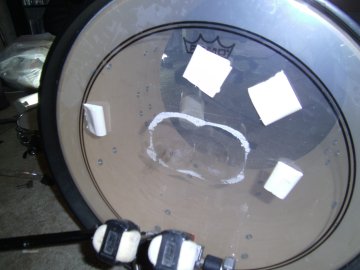Bass Drum Muffling
Contents
Bass drum muffling is one of those things that drummer love to argue about.
Some people say you should only do it this way or that way.
I’ll tell you to do whatever works for you.
So much of muffling the drum is dependent on how you’ve tuned your drumhead.
So what works for a very loosely tuned head most likely won’t work for a tight head. Regardless of how you’ve tuned the batter head, chances are that you’ll need to muffle it a bit.
There are many products available online (see drum mufflers), but I’d like to show you a few ways of muffling your drum using things you probably already have around the house.
Again, some of these might work for you, some might not. If you have a certain way that you prefer to muffle your drum head, please leave a comment below. I’m all about learning new ways of doing things and I’m sure other visitors would appreciate it.
You can watch the video below to hear how these different methods effect the sound. Once you’ve watched the video, I’ll discuss the options a bit more below.
Bass Drum Muffling Tips
The most common method of muffling the bass drum I’ve seen other drummers use is a pillow. It really deadens the overtones and ringing, giving you a nice thump that you can the rely on the soundman to adjust.
Just lay it out flat across the bottom of the bass drum shell and it will control a lot of ringing and overtones. For an even more controlled sound, push the pillow up against the batter head.
I tried using a towel in the video above because it was recommended to me by another drummer. Personally I don’t care for it, but if you think the pillow kills the drum too much, it might be a good way to go.

I’ve also seen drummers place duct tape on their drum heads. This is most commonly used on toms, but the bass head is another place you could use it.
I’ve also heard that you can roll up some tissue inside the duct tape for extra muffling. Just be sure whether you put it on toms or the bass, that you place the duct tape somewhere that you will not hit it with your drum sticks or the bass drum beater.
It will ruin your beaters and kill the ability to roll on your heads. I never tried the duct tape and tissue paper until I made the video above. I don’t feel like it really did a whole lot to muffle the drum, but if used in a studio situation, it might be more effective.
One of the best possible things you can do for bass drum muffling, is to use a kick pad. These pads greatly improve the sound of your bass, they offer muffling of overtones, and they help to increase the life of your drumhead.
I like to use them during practice when I’m not mic’ed up. Sometimes it can be hard to hear my footwork over the rest of the band, but with a metal click pad on my bass drum I can hear everything I do much clearer.
The one in the picture is a click pad with a rubber coating over it. It’s a less intense click and it’s the pad I use for playing shows.
I also have a full-metal pad that I use for band practice. It doesn’t have much bounce so it makes rolling harder, but it can be heard over just about any level of noise the guitarists throw at me.
As great as impact pads are for bass drum muffling, there is one major setback for them. They don’t always stay stuck to the drumhead.
They are prone to coming off and flapping all over the place. So, to correct that I always duct tape it to the bass drum head.
I know, I know. I always tell you not to put duct tape on your drumheads, but this is one situation where I feel the pros outweigh the cons.
If your pad comes off while you’re playing, the beater is going to go right in to that sticky spot left by the pad and it won’t be the same again.
Place your duct tape as I have it in the picture and you won’t have to worry about the pad coming off or getting your beater stuck in the tape.
Do you have a certain way you prefer to muffle your drums? Leave a comment below.
When you’re done be sure to check out some of my other drum lessons:




New! Comments
Leave your comments below.